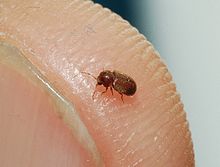|
Bookworm (insect)   Bookworm is a general name for any insect that is said to bore through books.[1][2] The damage to books that is commonly attributed to "bookworms" is often caused by the larvae of various types of insects, including beetles, moths, and cockroaches, which may bore or chew through books seeking food. The damage is not caused by any species of worm. Some such larvae exhibit a superficial resemblance to worms and are the likely inspiration for the term, though they are not true worms. In other cases, termites, carpenter ants, and woodboring beetles will first infest wooden bookshelves and later feed on books placed upon the shelves, attracted by the wood-pulp paper used in most commercial book production. True book-borers are uncommon. The primary food sources for many "bookworms" are the leather or cloth bindings of a book, the glue used in the binding process, or molds and fungi that grow on or inside books. When the pages themselves are attacked, a gradual encroachment across the surface of one page or a small number of pages is typical, rather than the boring of holes through the entire book.[3] The term has come to have a second, idiomatic meaning of a bibliophile, who reads a great deal or to perceived excess: someone who devours books metaphorically. Booklice The booklouse, also known as a paperlouse, is a soft-bodied, wingless insect in the order Psocoptera (usually Trogium pulsatorium), typically 1 mm or less in length. Booklice feed on microscopic molds and other organic matter found in or on aging items that have been stored in places that lack the climate control necessary to inhibit organic growth. Areas of archives, libraries, and museums that are cool, damp, dark, and generally undisturbed are common sites for such growth, generating a food source which subsequently attracts booklice. Booklice will also attack bindings, glue, and paper. Despite their name, booklice are not considered to be true lice, as they do not feed on a living host. By the 20th century, bookbinding materials had developed a high resistance against damage by various types of book-boring insects.[4] Many museums and archives in possession of materials vulnerable to booklouse damage employ pest control methods to manage existing infestations and make use of climate control to prevent the growth of potential booklouse food sources.[5] Other book-eating insectsBeetlesOf the quarter million species of beetles, some adults damage books by eating paper and binding materials themselves. However, their larvae do the most damage. Typically eggs are laid on the book's edges and spine. Upon hatching, they bore into, and sometimes even through, the book.[3] 
 These beetles have been known to feed on leather bindings.
TermitesTermites are the most devastating type of book-eating pest. They will eat almost every part of a book including paper, cloth, and cardboard, not to mention the damage that can be done to shelves. Termites can make entire collections unusable before the infestation is even noticed.[3]  AntsSome species of ants can damage books in a way that is similar to termites.[11] MothsClothes moths will, in addition to attacking clothes and fabrics, also feed on bookbindings, decaying organic material (which includes paper), and mold.
CockroachesBook-damaging cockroach species chew away at the starch in cloth bindings and paper. Their droppings can also harm books.[3] These insects consume portions of books that contain polysaccharides. Paper that is slightly ragged at the edges is usually the work of silverfish.[3][12]   ManagementHuman awareness of bookworms dates back to the Middle Ages, when infested books were identified and burned.[16] Pesticides can be used to protect books from these insects, but they are often made with harsh chemicals that make them an unattractive option. Museums and universities that want to keep their archives bookworm free without using pesticides often turn towards temperature control. Books can be stored at low temperatures that keep eggs from hatching, or placed in a deep-freezer to kill larvae and adults. The idea was taken from commercial food storage practices, as they are often dealing with the same pests. [15][17] Pseudoscorpions such as Chelifer cancroides may live in books and feed on book-eating insects, controlling their numbers.[18] In human cultureBookworms were one of the threats to book preservation identified by 19th Century collector and printer William Blades in his work The Enemies of Books.[16] How to protect papyrus, paper (and later parchment) collections from bugs is a topic that already Aristotle was interested in and that kept librarians busy through the centuries.[19] The term bookworm is also used idiomatically to describe an avid or voracious reader,[20] or a bibliophile. In its earliest iterations, it had a negative connotation, referring to someone who would rather read than participate in the world around them. Over the years its meaning has drifted in a more positive direction.[21] Bookworm is a word-forming puzzle video game developed by PopCap Games that follows Lex, an actual bookworm who accompanies the player as they form words from the deck. From a grid of available letters, players connect letters to form words. The game was well received by various audiences and has become the most downloaded word puzzle game, being downloaded over 100 million times. The game was given a follow-up entitled Bookworm Adventures. ReferencesCitations
Further readingWikimedia Commons has media related to Bookworms. Look up Bookworm in Wiktionary, the free dictionary.
|
